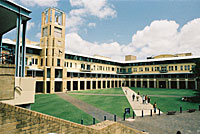|
||||||||||||||||||||||||||||||||||||||||||||
| Continuous-Time Finance - FINS5591 | ||||||||||||||||||||||||||||||||||||||||||||

Description The course consists of two major parts. The first one is a more technical prerequisite of the second, but it delivers its own insights into the modelling of financial problems. It deals with Stochastic Calculus as a basis to model the stochastic development of asset prices, interest rates or latent variables. At the end of this part students should be familiar with Ito's Lemma and stochastic differential equations. This part asks for a positive attitude of students towards a more formal reasoning. It will take up about 20% of the lectures.
The second part deals with a number of classical continuous-time applications in Finance. First, three problems which areas based local on a no-arbitrage condition will be discussed: option pricing, structural models of credit risk, and the trade - off theory of the optimal capital structure. Second, portfolio theory and the characterization of expected asset returns in equilibrium will be analysed. These two problems were the first applications of the continuous-time finance approach. The last topics are devoted to no arbitrage term structure theories and to the general equilibrium theory as developed by Cox/1 ngersoii/Ross. |
||||||||||||||||||||||||||||||||||||||||||||


